Introduction
March 15, 2020 - we are under siege.
That's how I started my therapeutic diary that day. Under the impulse of what I was feeling at the time, these were the only words I could lay down on the paper that invited me to a long self-disclosure.
Now I look at this brief and radical conclusion and try to figure out what determined me to see reality from such a dramatic perspective. The day was beautiful, calm and warm, the happy children were preoccupied with their little childish pleasures, my husband was caught up in the same blessed routine and I was confused because nothing around me justified the storm in my mind and soul. Beyond the home picture in the living room conquered by children, toys and a husband turned into a children's toy, I saw the serious face of the country's president on the frozen screen of the TV announcing the end of normality and the beginning of new normality in which a virus, COVID 19, will tell me, through people, what I’m allowed and what I’m not allowed to do. Then the crisis hit me! And I went to war!
Let there be war, but whom I am fighting with!? I went through many crises, for example when I fought with my mother who left me in kindergarten at the age of two because she "had to", with the communist system that forced me to humiliate myself for a loaf of bread, a pair of shoes or a book, with the parents and all the adults who tried to shape me to their liking when adolescence forced me to claim my freedom, independence, to respect my uniqueness and identity, with my high school boyfriend who loved me today, ignored me tomorrow and constantly put me through a sweet purgatory, with my helplessness when the Faculty of Social Work didn’t want me to be its student and put rejected next to my name, at the admission, with God when he forced me to see my grandfather die. My whole life has been sprinkled with crises and I managed to get over them knowing whom I was fighting with. The question keeps arising: "Whom am I fighting now?".
I know that I am in the middle of a crisis because everyone around me tells me this: my caring mother, my panicked colleagues, all friends on Facebook, the moderators on all TV stations. I currently don’t see anything changed around me and I don’t understand where the threat comes from!
Wait, I remember! I tell my students that any crisis comes first with a deceptive "denial." I also tell them to be careful because denial traps exactly the people who are strong, balanced, and self-confident in their "normal" life. I think I fit in too! "Why is denial bad if I function at normal parameters?". Denial influences my ability to perceive reality by selecting only the aspects that correspond to my inner reality. But if I tell myself that there is no danger, it doesn’t mean that it doesn’t exist in reality and I only succeed in putting myself in real and imminent danger through denial.
I decide to shake off this pseudo-protective thinking and step timidly towards the next phase of the crisis, that of intense feelings. The transition from the silence of denial to the storm of panic, with all its series of states, is so sudden that I remain stuck in myself, in my mind and soul. I feel the fear of illness, death, I feel the fear that I will lose my parents, children, mind, that the ordinary needs of yesterday will become a luxury today, I feel frustration, a lot of frustration because everything I have achieved, all my meticulously built life can fall apart and nothing will make sense anymore and above all, I am afraid for tomorrow just because I am very afraid now, today.
I burn all these states after I let them manifest themselves. I remember a dear teacher from my student years who advised us not to kick anything we create and to accept everything as part of us. It gave meaning to the expression that "Nothing is accidental!" and said that automatically eliminating something from us just because we don't like it, we don't control it, is a clear sign of emotional vulnerability, cognitive fragility. I accept the fears, worries, frustrations because they are mine, I created them, helped by a hostile world. If I accept them, I understand them!
I can control, transform and repair what I can understand! Now that I know why they are alive in my mind, I have only one task left: to animate those parts of me capable of representing me with heroism but not by defeating the "enemy", but by helping me to make it an ally! The world is full of enemies! I want to make this crisis a deserter from the army of hostility that will help me fight all the future crises.
My inner heroes managed to make the crisis an ally when I adapted myself because, in the end, that's what happened. Adaptation means that I matched my needs and desires with the requirements of the outer, new, changed world, different from what I knew and controlled.
Because I went through a “different” situation that exploited me “differently”, I am willing to learn from it, to evolve, being aware that change, redefinition, rediscovery are not required and expected in normal, daily life and that all of them don’t strive for my perfection as a human being.
This book follows the scenario based on which I experienced my global COVID 19 crisis. Helped by everything I knew and how I knew myself, I went through the crisis, step by step, being the practical application of a scientific textbook theory. That is why the scenario can be replicated on any other person and any other type of crisis.
In essence, the mechanism of a crisis is relatively simple: the occurrence of the crisis, the main factors, external ones in the case of COVID 19 or internal ones in the case of developmental, existential crises – it stimulates acting on the person - the person resists, denial or minimization being the most common ways – the domination of the person through the appearance of fears, worries, frustrations, anxious tendencies - the fight with the stimuli and the personal states generated by the crisis. The confrontation, alone or with allies, can be completed in two ways, namely by annihilating the person, this option taking dramatic forms, such as the development of mental disorders, anxiety and mood disorders being common, but cognitive (content) or personality disorders can be triggered in the case of a vulnerable background. The second option, the preferred one, involves adapting the person to the new context by capitalizing on his/her resources. The adaptation can have positive consequences because it pushes the person towards progress or negative because it determines the person's regression.
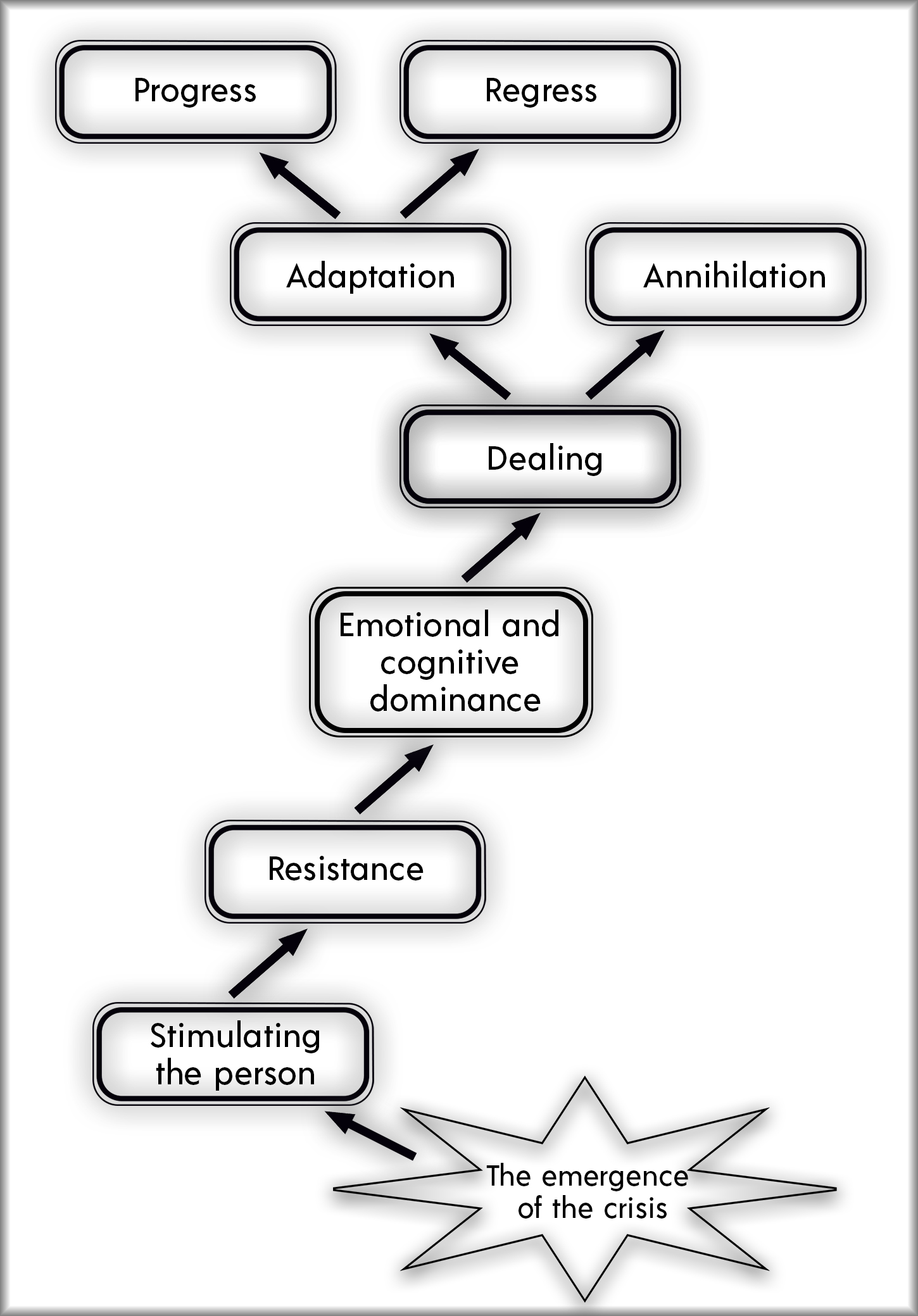
I have structured the book into three parts that operationalize this simple and edifying scheme of the crisis manifestation, regardless of its nature. The first part is dedicated to the weapons that the crisis throws into the war. It has only one tool with which to start the assault: the change. The crisis is defined as a tense period triggered by a radical change. The "intelligence" or "perversity" of a crisis is reflected in the fact that it manages to make our states its weapons, through its novelty. We expose the essential weapons, namely fear, dread, anxiety, frustration.
I have allocated large spaces to these states, to capture the particularities and conceptual and procedural differences, to identify how we can fight them. I analyzed the fear, the dread, the anxiety, the frustration felt by a functional person, disturbed by a crisis, to help him/her get over this period with minimum losses. I don’t address mental disorders but situational mental disturbances. That is why, for example, I use the term anxiety in general or anxious tendencies but I don’t treat anxiety disorders, those that target people with clinical diagnosis in this regard. We all had situational anxieties, we have and will continue to have them, without developing an anxiety disorder and the dedicated chapter is built starting from this "normality".
The second part is where we learn to identify and sharpen our weapons. I started from the psychoanalytic concept that postulates that a person is mentally healthy when he/she is balanced. It is a pertinent and simple conclusion but how a person can reach the state of balance, this is an extreme challenge. I tackled balance through the prism of harmonizing the instances of self-image, respectively the Real ego with its series of children, the Future ego and the Ideal ego. The optimum crystallization of these selves and their harmonization guarantee the personal balance expressed in the ability to accept oneself, to have self-confidence but also confidence in the world and the future.
Finally, we let the weapons cross but we provide options to extinguish the war and to declare ourselves victorious. Informed or not, reading this book or not, most of us win the war using the most common way: “trial and error!”. Its advantage is that it doesn’t require training but its disadvantage is that it can cause significant personal harm and the victory day can find the person so exhausted and hurt that he/she can no longer enjoy it. The ways presented in the book are those that others, the specialists, have tried, adapted, replicated on many people and situations. You receive thought, tried and validated strategies! All you have to do is select the one that suits you in the crisis you are going through.
I also reveal the methods by which I try to keep your mind captive between these pages, namely exemplification, self-disclosure, guided projections, psychological tests and many awareness exercises.
I wrote these lines inspired by the COVID 19 crisis and the apocalyptic crises that it prepares to trigger as a chain reaction. But it’s not a book dedicated to this crisis. No matter how great it is now promoted worldwide, it doesn’t deserve the role of star in my book. The crisis generally is the main character. The crisis of the child who enters a community for the first time and has the impression that he/she has been abandoned by his/her parents, of the child who is humiliated by his/her schoolmates, of the teenager who fights for his/her freedom, of the abandoned girlfriend or disappointed boyfriend, of the young mother and the new father surprised by the responsibility of the new role, of the neglected or abused wife, of the loss of a loved one. All these crises, without explicitly naming them, are the subject of this book.
If you expect a treaty about principles, theories, about "some say", "others confirm", please use the book as a support for your cup of coffee or to keep the bedroom door open. If you want to understand exactly what is happening to you, now, when you feel the blows of the crisis in your stomach, when it haunts your sleep, when it disturbs your mind, when it affects your daily life, when you feel that you cannot take it no more and have the tendency to desert and say to yourself "Happen what may, I hope it ends!”, to understand "Why?" and so that you can answer "What am I doing?", then this book will be of real help to you.
You will be mirrored in it and you will have the impression that someone wrote it especially for you. However, I wrote it for myself to give meaning to my storm but it got a general touch because what I live is not unique. How I live is unique but what I live is common and if you find yourself between these pages, it shows you how normal all your feelings are, even if now you have the impression that they are inhuman, abnormal, strange and on the verge of madness.
Let’s understand fear
If you had not experienced fear several times in your life, you would have currently been only a memory in the minds of those who instinctively understood that fear is the guarantor of life. The pure reality lies beyond the drama, behind these words, fear being the emotion that activates our survival instinct.
You were afraid many times, you acted according to the cause that generated this emotional reaction and in proportion to the severity of the situation. You forgot most of these situations because your fears rarely reached maximum levels and you were completely unprepared, being forced to invest everything you have to survive.
Fear is an emotional reaction occurring in a situation perceived as dangerous and involves a surprise factor. However, for most situations, our fears have been prepared and even if the unpredictability of a situation initially confuses us, we have the resources to quickly reset ourselves and have adequate reactions, adapted to the severity of the situation. We were trained for most of the dangers since we were young. We were taught how to react to fire, drowning, car accidents, bad people, and especially to prevent such situations, starting from the traumatic experiences of others. Most of us have not been traumatically “introduced” to fire but we know how to react in the face of danger. Although our heart beats extremely fast and we are paralyzed for a few seconds, we react immediately and move away from the fire or extinguish it. We instinctively avoid people we think can hurt us, dark and lonely places in a built-up area, etc.
The parents, who have experienced a set of fears and learned from them, gradually passed on to us these modes of reaction, thus the surprise of the dangerous moment that generates fear is quickly replaced by an appropriate, saving reaction. The more our parents experienced fears and communicated them to us in a complete, cause-reaction-solution package, the more familiar we are with fear, the more accustomed our brain is to help us in extreme situations. The current crisis has not been experienced by us or our parents, which allows fear to become the master of all, forcing each of us to learn to react. If we do not learn, we are lost!
Impact of fear
The first thing we need to learn is to understand this fear and respect it in terms of its saving value. Fear of the coronavirus crisis is a wake-up call, just like any other fear of ours. It differs from others by its novelty, by the fact that no one and nothing prevented us and we have to manage on our own, using exclusively our resources. The lack of immediate reaction amplifies the intensity of fear and can lead to impulsive reactions, fuelled exclusively by emotions, in which our rationality is fully annihilated. That is why it is vital to be aware of how this fear occurs, its role and that the information can restore the role of productive leader of our rationality in the decision-making act.
A dangerous situation is perceived by a person as a set of information received by analysers through the sense organs, which reaches the cortex, where they are encoded and processed. Following the initial coding, called input coding, two important codes are obtained: the bioelectric one that establishes the quality of the information and the spatial-topographic one. The impulses generated by a dangerous situation activate cortical foci in the reptilian brain.
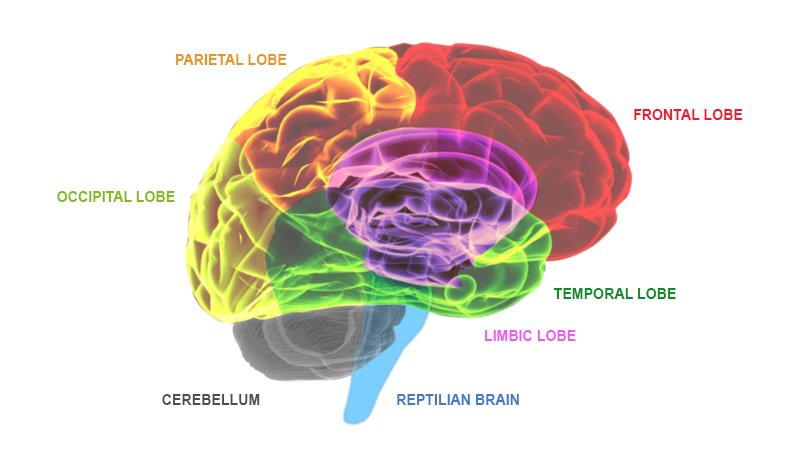
The reptilian brain is the oldest cortical formation, also found in mammals and reptiles, hence its name. It is responsible for generating and managing primary instincts and primary emotions, especially negative ones. Fear is a primary emotion, being encountered in the new-born. These are experiments that test the development of fear in babies who have not gone through the process of learning a saving emotion, babies who were afraid when they heard a loud or unfamiliar sound.
After the focus of fear is activated, the brain looks for a response scheme, starting from the available data, generated by the dangerous situation. It is like searching for a solution on Google. The brain looks for a response-solution and the simplest way is to see how it acted in a similar situation in the past, what answer it has prepared, and to offer the same or a relatively slightly redefined one. The brain's response-solutions are the neural diagrams and it looks for the right pattern based on the data provided by the crisis experienced by you and received by the brain. The novelty of the situation overwhelms even the most complex aggregate because it does not find any similar or close scheme to offer you and thus it has only one option: to build a new one.

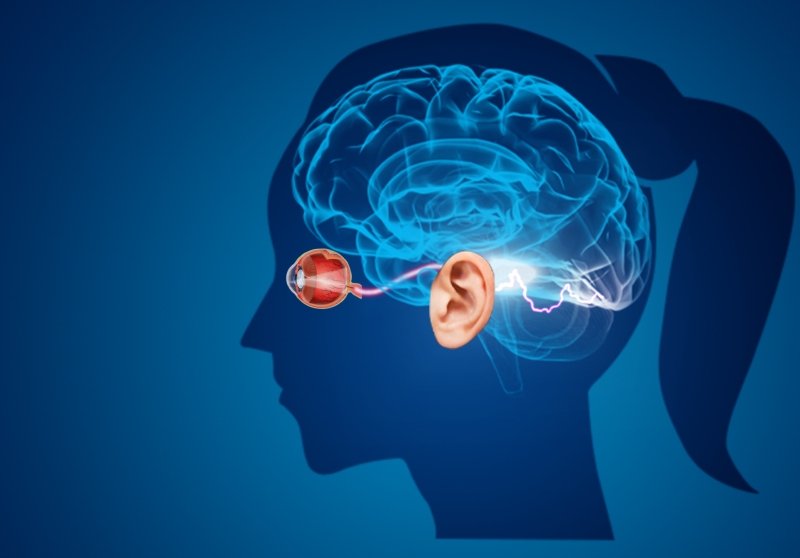
The search process takes time to be constructive and sometimes we do not have the resources for obtaining more time to design and build schemes or the situation is so pressing that it sends acute messages to the brain, such as “until you build it, tell me what to do NOW!”. The brain also conforms, without allowing the other superior cortical systems to intervene, and two primary reactions are sent from its primary area: run or fight! You run, isolate yourself in the house, or fight, put on a mask, gloves and continue to improve yourself, fighting against the position of deserter inoculated as vital by this virus, if you want to survive. The fact that you have isolated yourself proves to be a saving solution, as well as the one of remaining in battle, protected. The novelty of this dangerous situation is that it no longer produces fear after the initial moment because we have already reacted but it generates anxiety, panic in some people (we will deal with them separately). However, fear remains suspended in the air and occurs in other small situations encountered and generated at this time. We can no longer say that we are afraid of coronavirus in general because we have already become aware of its presence, the element of surprise has disappeared and we had the first reaction. However, fear has now been replaced by the fear of coronavirus which has particularly turned into the fear of one's death, fear of losing the loved ones, fear of pain, fear generated by our helplessness, and loss of control over our existence. It is very important to distinguish between these two complex states because each involves the use of certain weapons into battle.
Fears do not vanish! The cough of a stranger in the same queue at the cash register in a supermarket generates fear. A police crew pulling you over generates fear. An ambulance in the parking lot of the apartment block where you live or just the sirens of an ambulance make you freeze. A ringing phone paralyzes you because you don’t know the message it sends. People were coughing in public before, the police were on the streets, the ambulances furrowed the hustle and bustle of the day or the silence of the night with their shrill sirens, the phone rang constantly and everything was normal, maybe we did not even notice them. Now, after a major initial fear, transformed into a fear that still haunts us, all these are situations that generate fear and it is necessary to have an adapted and constructive response to it. Impulsivity does not help us: we cannot run away from the queue or hit the one who coughs because we project a danger in that person. We cannot run away from the police, nor do we confront them just because their actions remind us that we live in troubled times. We do not break connections with the world, we do not barricade ourselves, we do not choose ways to make our condition worse.
Stop fear!
The fear of coronavirus has become extreme and paralyzing because it did not dissipate after becoming familiar with the surprise stimulus, the virus, with which many of us did not even have direct contact but took on many other forms that attack us when we least expect it.
A viable weapon against these fears is to give ourselves time and not react impulsively. The situation does not require impulsivity. It has the advantage of giving us time to find solutions. It is not like when a potential killer jumps on your back and the impulse can save you. In this case, the killer made his presence felt when we found out about him, sitting comfortably in front of the TV. The situations generated daily no longer require impulsivity. Any alarm that makes your blood boil in your veins and your brain freeze, apparently emptying itself of saving thoughts, can be extinguished by giving us a brief conscious respite. I mentioned that in the face of a new situation, the brain does not have a quick response, it does not find a saving scheme in our personal history and its huge warehouse, so it gives us those extreme sensations and seems to leave us exposed, sure victims. However, the brain, after a failed search, did not give up. It only needs a little time to finish its job, namely to build a new neural scheme, new pathways, activating various cortical foci.
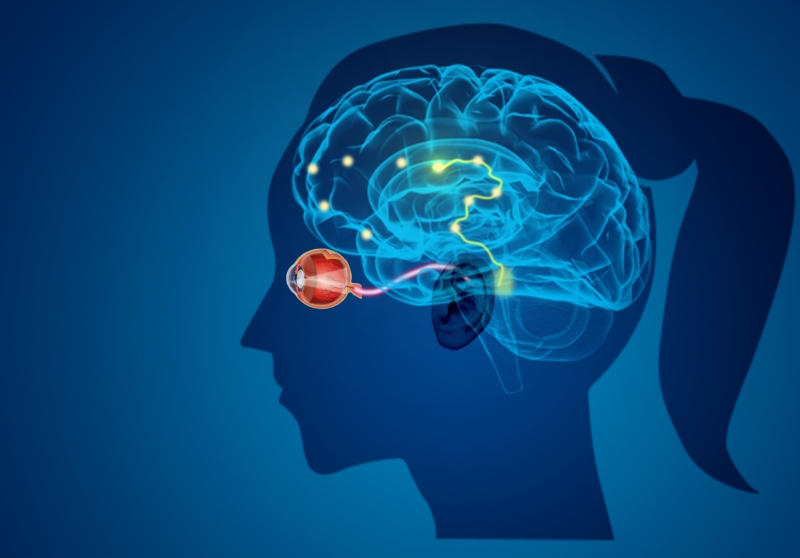
The construction of a new scheme involves the activation of cortical foci mainly in the limbic system and neocortex and thus higher processes such as thinking, memory, imagination, affectivity are activated and each provides the right answer, adapted to the situation. Our fears call for a break that you can consciously give from today.
Take a careful look at this image:
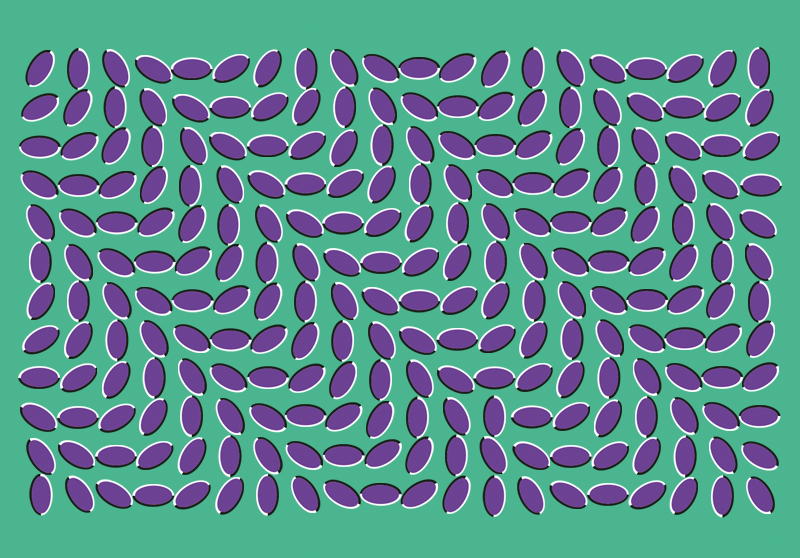

Don't you notice the moving leaves? The movement is slower for some people or faster for others but present for all. Take a closer look at the image, take a deep breath, and hold it for a few seconds. The leaves no longer move, the image froze. That is how our receptors froze and the brain was not bombarded with any new stimuli for a few seconds and so it received exactly what it needed: time to build an effective scheme using the information it already received, coded, stored at the cortical level.
Studies show that it takes between 0.3-5 ms to achieve the process of release-diffusion-determination of links between neurotransmitters at the level of a neural synapse and a neural network involves a varied number of such synapses, depending on the quality of stimuli. Fear is primary according to the impact but complex according to the process triggered at the cortical level, so it requires time and protection from new stimuli to provide a prompt response, adapted to the context.
In the coronavirus crisis and the following connected crises, fear can be managed by a simple artifice such as taking a break from receiving new stimuli. Take a deep breath and count to 3. Repeat the action as many times as necessary to calm down and get out of the empire of exhausting emotion that dominates you. Do this consciously and your unconscious will know what to do. You started the balancing and a mechanism that moves with a single purpose: to help you make the best decision and the most adapted and efficient reaction.
It sounds so simple, doesn't it!? You may be wondering why I didn't say it from the beginning: take a deep breath and count to 3 and ... that's it! Yes, the action is simple but only if it is prepared through an awareness process. I helped you to become aware, to activate cortical and emotional foci by detailing the elements that define fear, by exposing the process of fear production. You only need to make the connections through rest.
